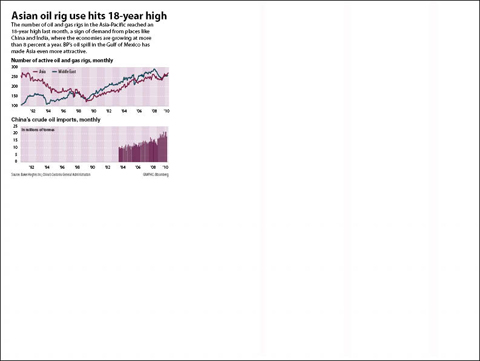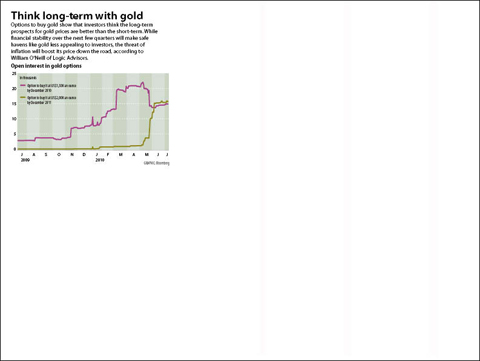Raw material prices traded mixed this week as dealers assessed the outlook for demand amid weaker economic data in the US and China — the world’s biggest commodity consumers.
OIL: Oil prices fell during volatile trading.
“Some economic data in the United States are signalling slower economic growth and that has put a lid on any price rally,” said Victor Shum, an analyst with energy consultancy Purvin and Gertz.

He said oil prices were likely to trade between US$70 and US$80 a barrel for some time.
“There is really no big driver to cause oil to break out of this range,” Shum added.
OPEC, which pumps 40 percent of the world’s crude, this week forecast a 1.2 percent increase in global oil demand growth next year.

By late on Friday on the New York Mercantile Exchange, Texas light sweet crude for delivery in August fell to US$75.60 a barrel from US$76.04 the previous week.
On London’s Intercontinental Exchange, Brent North Sea crude for September delivery stood at US$74.96 compared with US$75.39 for the August contract, which expired this week.
PRECIOUS METALS: Gold prices dropped under US$1,200 an ounce on profit-taking after being the “out-performer in the precious metals complex over the past few months,” Deutsche Bank analyst Adam Sieminski said.
The metal hit an all-time peak of US$1,265.30 an ounce on June 21.
By late on Friday on the London Bullion Market, gold fell to US$1,189.25 an ounce from US$1,208.75 the previous week.
Silver rose to US$18.25 an ounce from US$17.87.
On the London Platinum and Palladium Market, platinum fell to US$1,505 an ounce from US$1,527.
Palladium increased to US$456 an ounce from US$454.
BASE METALS: Base metal prices dropped amid weaker manufacturing across Asia.
By Friday on the London Metal Exchange, copper for delivery in three months had slipped to US$6,483 a tonne from US$6,722 a week earlier.
Three-month aluminum fell to US$1,978 a tonne from US$2,000.
Three-month lead decreased to US$1,770 a tonne from US$1,835.

Authorities have detained three former Taiwan Semiconductor Manufacturing Co (TMSC, 台積電) employees on suspicion of compromising classified technology used in making 2-nanometer chips, the Taiwan High Prosecutors’ Office said yesterday. Prosecutors are holding a former TSMC engineer surnamed Chen (陳) and two recently sacked TSMC engineers, including one person surnamed Wu (吳) in detention with restricted communication, following an investigation launched on July 25, a statement said. The announcement came a day after Nikkei Asia reported on the technology theft in an exclusive story, saying TSMC had fired two workers for contravening data rules on advanced chipmaking technology. Two-nanometer wafers are the most

NEW GEAR: On top of the new Tien Kung IV air defense missiles, the military is expected to place orders for a new combat vehicle next year for delivery in 2028 Mass production of Tien Kung IV (Sky Bow IV) missiles is expected to start next year, with plans to order 122 pods, the Ministry of National Defense’s (MND) latest list of regulated military material showed. The document said that the armed forces would obtain 46 pods of the air defense missiles next year and 76 pods the year after that. The Tien Kung IV is designed to intercept cruise missiles and ballistic missiles to an altitude of 70km, compared with the 60km maximum altitude achieved by the Missile Segment Enhancement variant of PAC-3 systems. A defense source said yesterday that the number of

A bipartisan group of US representatives have introduced a draft US-Taiwan Defense Innovation Partnership bill, aimed at accelerating defense technology collaboration between Taiwan and the US in response to ongoing aggression by the Chinese Communist Party (CCP). The bill was introduced by US representatives Zach Nunn and Jill Tokuda, with US House Select Committee on the Chinese Communist Party Chairman John Moolenaar and US Representative Ashley Hinson joining as original cosponsors, a news release issued by Tokuda’s office on Thursday said. The draft bill “directs the US Department of Defense to work directly with Taiwan’s Ministry of National Defense through their respective

Tsunami waves were possible in three areas of Kamchatka in Russia’s Far East, the Russian Ministry for Emergency Services said yesterday after a magnitude 7.0 earthquake hit the nearby Kuril Islands. “The expected wave heights are low, but you must still move away from the shore,” the ministry said on the Telegram messaging app, after the latest seismic activity in the area. However, the Pacific Tsunami Warning System in Hawaii said there was no tsunami warning after the quake. The Russian tsunami alert was later canceled. Overnight, the Krasheninnikov volcano in Kamchatka erupted for the first time in 600 years, Russia’s RIA